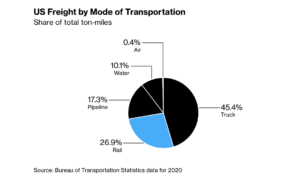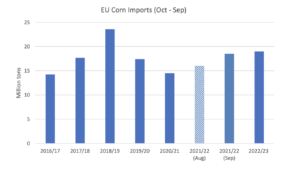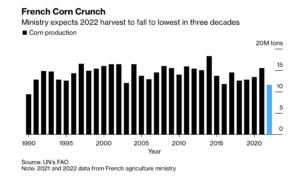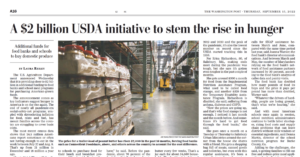Tentative Rail Agreement Reached- Averting Strike, as EU Drought Toll Continues, and Ukraine 2023 Winter Wheat Sowing Begins
Wall Street Journal writer Ken Thomas reported today that, “The White House said Thursday it had reached a tentative agreement to avoid a potential railway strike that threatened to shut down a crucial vein of the U.S. economy.
The Biden Administration applauds all parties for reaching this hard-fought, mutually beneficial deal.⁰⁰Our rail system is integral to our supply chain, and a disruption would have had catastrophic impacts on industries, travelers and families across the country. (2/2)
— Secretary Marty Walsh (@SecMartyWalsh) September 15, 2022
“President Biden said the tentative deal ‘is an important win for our economy and the American people.’ He credited the unions and rail companies ‘for negotiating in good faith and reaching a tentative agreement that will keep our critical rail system working and avoid disruption of our economy.'”
Also today, New York Times writer Jim Tankersley reported that, “Nearly a third of U.S. freight moves by rail, second only to trucking. The Association of American Railroads estimated that a nationwide rail service interruption would have idled more than 7,000 trains daily and cost the economy more than $2 billion a day.”

Elsewhere, Dow Jones writer Yusuf Khan reported today that,
Europe’s scorching summer is expected to wither production of corn within the region, with production expected to fall to a 15-year low, according to a new report.
“French agriculture consultancy Strategie Grains said Thursday that it forecasts corn production to be just 53 million metric tons for the 2022-23 season–the lowest since 2007–as a consequence of the dry weather shrinking harvests across the E.U.
“The overall grain harvest has also been revised 2.5 million tons lower than the previous report last month to 264.6 million tons–25.7 million tons lower than the prior year.”
In its Grains: World Markets and Trade report earlier this week, the USDA’s Foreign Agricultural Service (FAS) indicated that, “Heat and drought have negatively affected European Union (EU) corn production for 2022/23, which is forecast at 58.8 million tons, down 1.2 million tons from last month and 17 percent lower than last year’s crop. End users appear to be preparing for lower domestic supplies by importing heavily in August and likely into September.”

More narrowly, Bloomberg writer Megan Durisin reported earlier this week that, “French farmers are collecting their smallest corn crop in more than three decades, highlighting the massive toll that summer drought has wrought on Europe’s food supplies.”

The Bloomberg article pointed out that, “The corn harvest has just kicked off in France, one of Europe’s agricultural heavyweights. The country’s production of the staple grain used to feed chickens and pigs will fall 25% to 11.6 million tons, the lowest since 1990, its agriculture ministry said Tuesday. The adverse weather has reduced harvests of almost all crops from last year, apart from oilseeds, the report showed.”
Meanwhile, Reuters writer Sybille de La Hamaide reported yesterday that, “This year’s maize, or corn, crop in Ukraine, one of the world’s largest exporters of the grain, is expected to fall to 30.24 million tonnes, as a lower area will likely be harvested amid the ongoing war, French consultancy Agritel said on Wednesday.
“The estimate would be down nearly 12 million tonnes from a record harvest in 2021, but only slightly below the five-year average, it said.”
Regarding Ukrainian wheat production, FAS noted in its monthly World Agricultural Production report on Monday that, “Ukraine wheat production for marketing year 2022/23 is estimated at 20.5 million metric tons, up 5 percent from last month, but down 38 percent from last year.”
Earlier this week, Reuters writer Pavel Polityuk reported that, “Ukrainian farms in almost all regions have started sowing winter wheat for the 2023 harvest, seeding 141,000 hectares, or 3.5% of the expected area, the agriculture ministry said on Tuesday.”
And a separate Reuters article yesterday by Pavel Polityuk indicated that,
The successes of the Ukrainian army, which has liberated a significant territory in the northeast and south of Ukraine, may improve the forecasts of the winter sowing area for the 2023 grain crop, a deputy agriculture minister said on Wednesday.
On the issue of the Black Sea export agreement, Reuters writer Michelle Nichols reported yesterday that, “U.N. chief Antonio Guterres said he spoke with Russian President Vladimir Putin on Wednesday about Ukrainian Black Sea grain exports and that he was hopeful a U.N.-brokered deal would be maintained and expanded to include Russian ammonia.”
A Reuters article from today reported that, “Russia’s Foreign Ministry said on Thursday that pipeline exports of ammonia, a crucial component of fertiliser, had been blocked by Ukraine.
“In a briefing, Foreign Ministry spokeswoman Maria Zakharova said that there were ‘no obstacles‘ to ammonia exports from the Russian side.”
In other news, Washington Post writer Laura Reiley reported in today’s paper that, “The U.S. Agriculture Department announced Wednesday that it is providing close to $2 billion in additional funding to food banks and school meal programs for purchasing American-grown foods.

“The announcement comes as key indicators suggest hunger in America is on the rise again. The end of nearly all pandemic-era social-safety-net programs, coupled with skyrocketing inflation for food, rents and fuel, has meant families across the country are struggling to cover basic costs.





